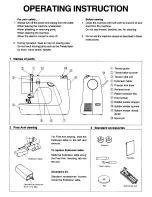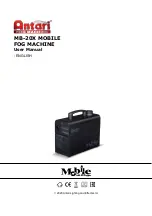
UTILITY STITCHES
——————————————————————————————————————————————————
48
DECORATIVE STITCHING
Various decorative stitches can be sewn with this sewing machine.
*Rfc.: Reinforcement
Stitch Name
Pa
tte
rn
P
res
ser Foot
Pattern No.
Application
Stitch Width
[mm (inch.)]
Stitch Length
[mm (inch.)]
Tw
in
N
ee
dle
W
alk
ing
Foo
t
Rev
ers
e/
Rei
nfor
cem
ent
Sti
tc
hing
70
st
it
ch
es
m
odel
60
st
it
ch
es
m
odel
50
st
it
ch
es
m
odel
40
st
it
ch
es
m
odel
Auto
Manual
Auto
Manual
Fagoting
stitch
J
17
17
17
17
Fagoting, smocking and
decorative stitching
5.0
(3/16)
0.0-7.0
(0-1/4)
2.5
(3/32)
1.0-4.0
(1/16-3/16)
Yes
( J )
No
Rfc.
J
18
18
18
18 Fagoting, smocking and
decorative stitching
5.0
(3/16)
2.5-7.0
(3/32-1/4)
2.5
(3/32)
1.0-4.0
(1/16-3/16)
Yes
( J )
No
Rfc.
Joining stitch
J
14
14
14
14 Patchwork stitching and
decorative stitching
4.0
(3/16)
0.0-7.0
(0-1/4)
1.2
(1/16)
0.2-4.0
(1/64-3/16)
Yes
( J )
No
Rfc.
J
15
15
15
15
Patchwork stitching, deco-
rative stitching and sewing
overcasting on both pieces
of fabrics, such as with tricot
5.0
(3/16)
2.5-7.0
(3/32-1/4)
2.5
(3/32)
1.0-4.0
(1/16-3/16)
Yes
( J )
No
Rfc.
J
16
16
16
16 Patchwork stitching and
decorative stitching
5.0
(3/16)
0.0-7.0
(0-1/4)
1.2
(1/16)
0.2-4.0
(1/64-3/16)
Yes
( J )
No
Rfc.
Shell tuck
stitch
J
12
12
12
12 Sell tuck stitching
4.0
(3/16)
0.0-7.0
(0-1/4)
2.5
(3/32)
0.2-4.0
(1/64-3/16)
Yes
( J )
No
Rfc.
Satin scallop
stitch
N
13
13
13
13 Scallop stitching
5.0
(3/16)
2.5-7.0
(3/32-1/4)
0.5
(1/32)
0.1-1.0
(1/64-1/16)
Yes
( J )
No
Rfc.
Decorative
stitch
J
19
19
19
19 Decorative stitching
4.0
(3/16)
0.0-7.0
(0-1/4)
3.0
(1/8)
2.0-4.0
(1/16-3/16)
No
No
Rfc.
J
20
20
20
20 Decorative stitching
4.0
(3/16)
0.0-7.0
(0-1/4)
2.5
(3/32)
1.0-4.0
(1/16-3/16)
Yes
( J )
No
Rfc.
J
21
21
21
–
Decorative stitching
5.5
(7/32)
0.0-7.0
(0-1/4)
1.6
(1/16)
1.0-4.0
(1/16-3/16)
Yes
( J )
No
Rfc.
N
22
22
22
21 Decorative stitching and
elastic-attaching
5.0
(3/16)
1.5-7.0
(1/64-1/4)
1.0
(1/16)
0.2-4.0
(1/64-3/16)
Yes
( J )
No
Rfc.
N
23
23
23
22
Lace sewing, decorative
hemming, heirloom
stitching, etc.
3.5
(1/8)
1.5-7.0
(1/16-1/4
2.5
(3/32)
1.6-4.0
(1/16-3/16)
No
No
Rfc.
N
24
24
24
23 Decorative hemming,
heirloom stitching, etc.
6.0
(15/64)
1.5-7.0
(1/16-1/4)
3.0
(1/8)
1.5-4.0
(1/16-3/16)
No
No
Rfc.
N
25
25
25
–
Decorative hemming on
thin, medium weight and
plain weave fabrics, heir-
loom stitching, etc.
5.0
(3/16)
1.5-7.0
(1/16-1/4)
3.5
(1/8)
1.5-4.0
(1/16-3/16)
No
No
Rfc.
N
26
26
26
24
Decorative hemming on
thin, medium weight and
plain weave fabrics, heir-
loom stitching, etc.
5.0
(3/16)
1.5-7.0
(1/16-1/4)
4.0
(3/16)
1.5-4.0
(1/16-3/16)
Yes
( J )
No
Rfc.
N
27
27
27
–
Decorative hemming on
thin, medium weight and
plain weave fabrics, heir-
loom stitching, etc.
5.0
(3/16)
1.5-7.0
(1/16-1/4)
2.5
(3/32)
1.5-4.0
(1/16-3/16)
Yes
( J )
No
Rfc.
N
28
28
28
–
Decorative hemming on
thin, medium weight and
plain weave fabrics, heir-
loom stitching, etc.
5.0
(3/16)
1.5-7.0
(1/16-1/4)
2.0
(1/16)
1.5-4.0
(1/16-3/16)
Yes
( J )
No
Rfc.
*
*
*
*
*
*
*
*
*
*
*
*
*
*
*
*
*
















































